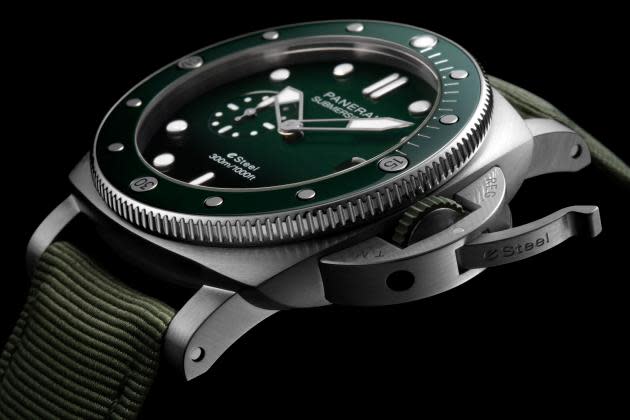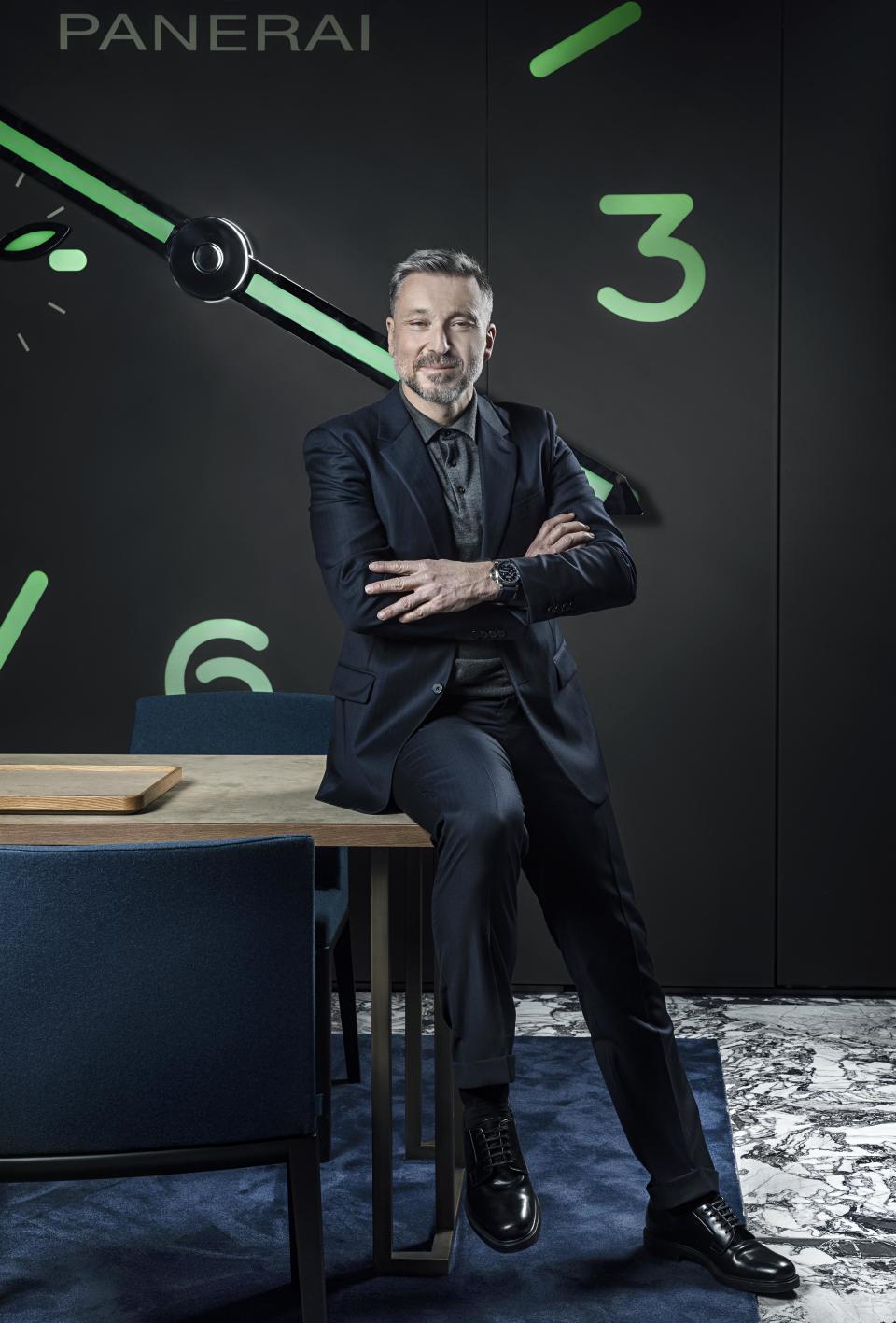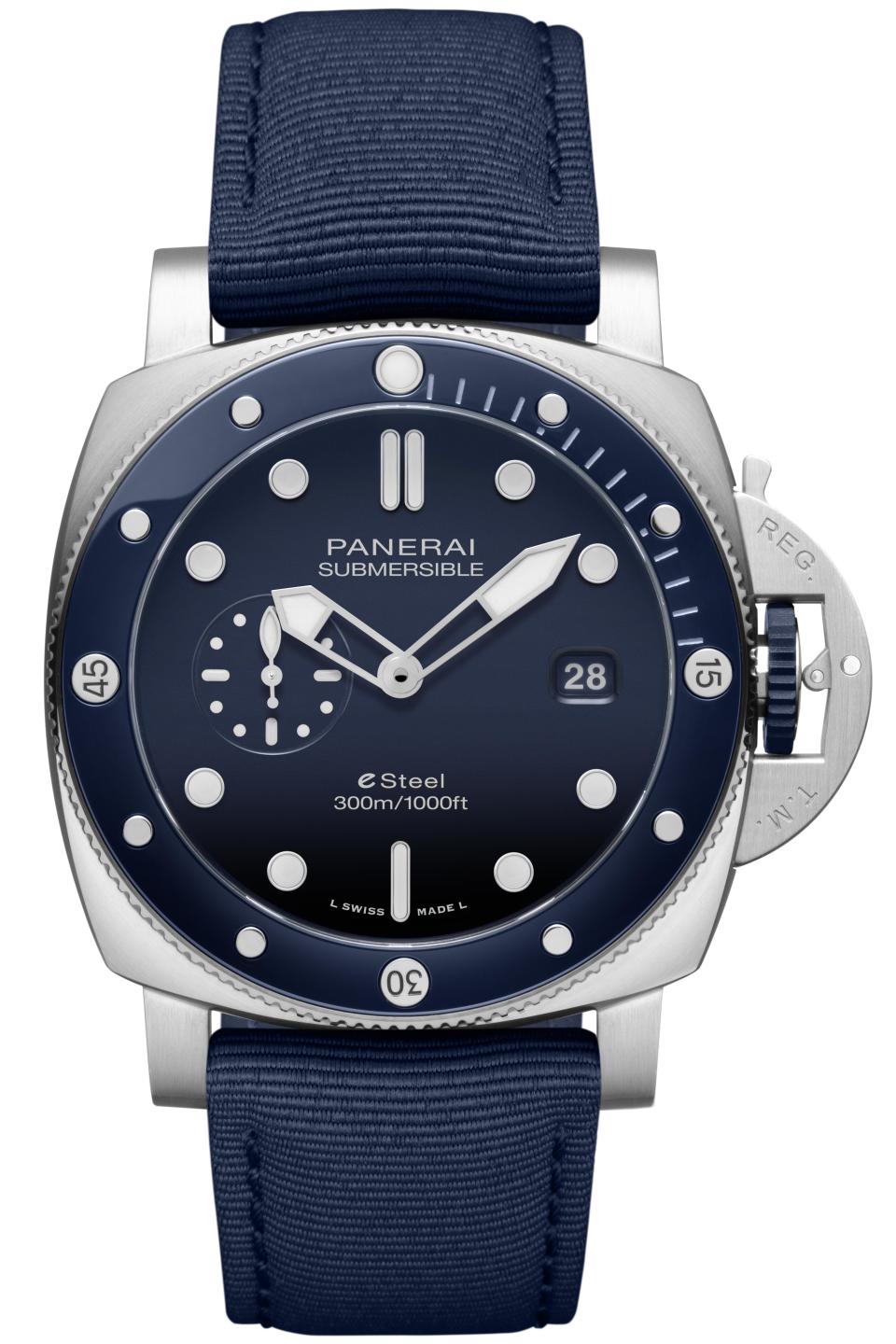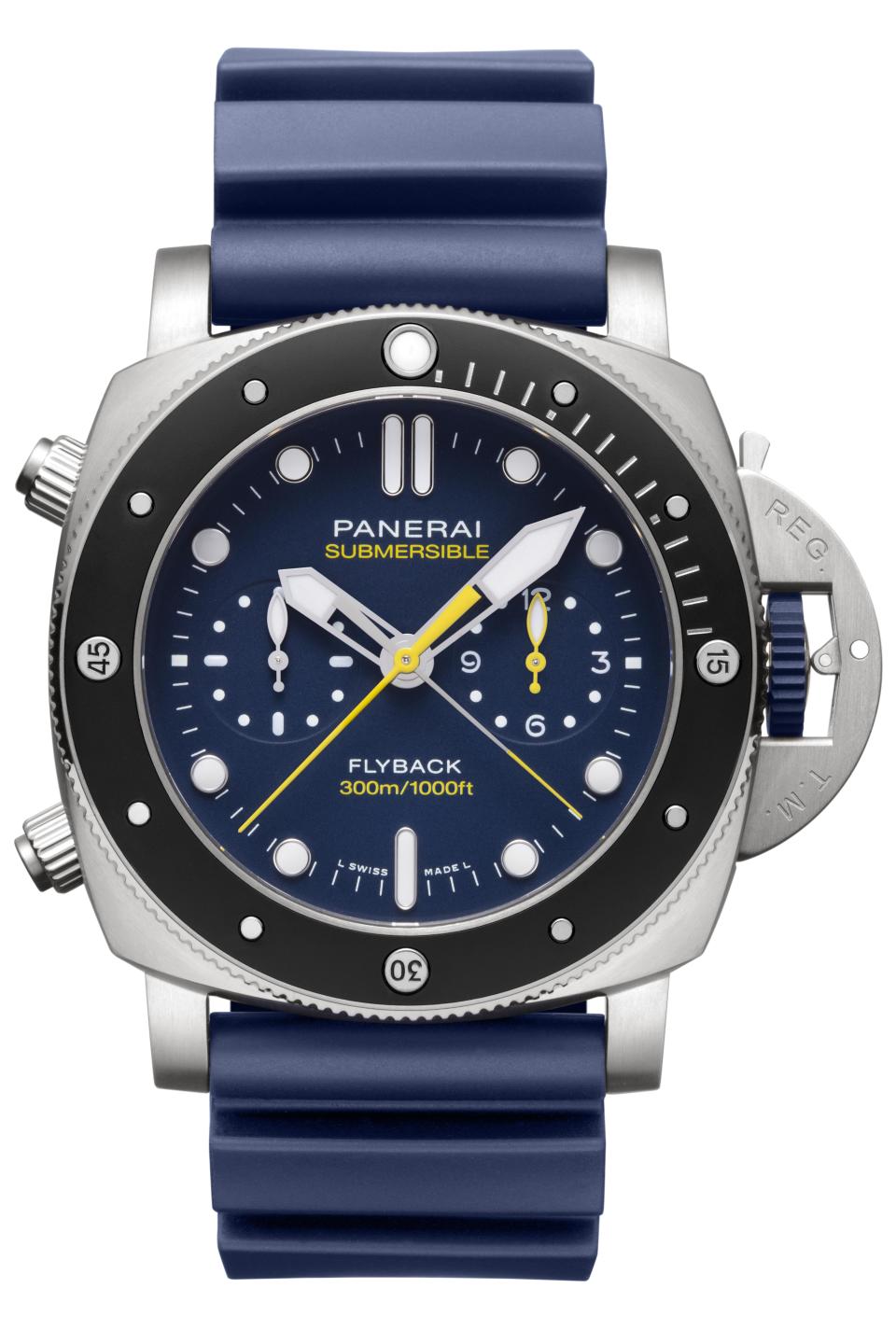The Panerai Playbook: Jean-Marc Pontroué Discusses His Eco Ambitions

A high-end watch brand is taking on the Goliath of global warming by sourcing recycled materials for its products and packaging, and inviting fellow makers to do the same.
Panerai’s chief executive officer Jean-Marc Pontroué has been defying watch industry convention in a number of ways.
More from WWD
Not only is he making watches with recycled materials, but he’s published lists of his suppliers in the hope that Panerai’s competitors can use similar metals and substances, so they can all drive prices down.
His collegial moves are unheard of in the secretive, and ultra-competitive, world of luxury watches.
Pontroué is also committed to using only recycled packaging by 2023 and looking outside — way outside — the industry for inspiration.
“We’ve learned a lot from the car industry, and from the Nespresso people. If they can recycle billions of coffee capsules, then why not us?” Pontroué said in an interview.

©
The French executive, who cycles to work like many of his other Richemont colleagues in Switzerland, has also been looking at the automobile industry’s shift to electric power.
“After 100 years, carmakers had to think differently, and they’ve invested billions in making changes. We don’t talk about that scale of investment in the watch industry, but we do feel a sense of responsibility to change the business model,” he said, adding that Panerai has a duty to make more sustainable products partly because of its historic connection to the ocean.
The company was founded by Giovanni Panerai in Florence in 1860 as a watch shop, a workshop and a watchmaking school. It supplied precision instruments, and later technical watches, to the Italian Navy, and later to the Egyptian Navy.
For most of its history, it’s been associated with the military and underwater performance, one reason why Panerai is working with UNESCO’s Intergovernmental Oceanographic Commission. Together, they are developing ocean awareness activities as part of the United Nations Decade of Ocean Sciences for Sustainable Development.
It was only in the early ’90s that Panerai began making watches for civilians. It was acquired by Compagnie Financière Richemont (then known as the Vendôme Group) in 1997 and has developed a cult following.
Collectors and fans of the watches, which range in price from around 3,800 pounds to upward of 60,000 pounds, are known as “Paneristi,” and once a year, a group of them — unrelated to the company — will meet to discuss the latest developments of the watches.
Panerai’s largest market is the U.S., where it has 20 stores. That’s partly down to Sylvester Stallone, who snapped up a host of Panerai watches while filming the 1996 film “Daylight” at Cinecittà studios in Rome, and gifted them to friends back in Hollywood — no doubt attracted by the watch’s unique oversize style — easier for a diver to see underwater and perfect for an action hero’s thicker wrists.
Today, Panerai owners include Michael Jordan, former President Bill Clinton, Arnold Schwarzenegger and Jason Statham. Earlier this year, Panerai got a free advertising boost after Dwayne “The Rock” Johnson wore the Panerai Submersible Goldtech OroCarbo while making his opening speech at the Super Bowl.
Courtesy of NASA, and a Panerai customer from Scottsdale, Ariz., Panerai has even traveled to the International Space Station to be tested in extreme temperature and pressure conditions.
Pontroué’s sustainability drive has been going for a few years now. The first effort was small, and inspired by one of the brand’s longtime ambassadors, the explorer Mike Horn, who approached Pontroué about a steel shaft, weighing about 10 kg, from his sailing yacht Pangea. He could no longer use it and was wondering whether Panerai could somehow give it a new life.

Courtesy Image
“So we brought it back to Neuchâtel [Switzerland] and asked the team what they could do with it. A couple of days later, they told me they could work with the metal,” Pontroué said.
The result was the Panerai Submersible Ecopangaea Tourbillon GMT 50mm Mike Horn Edition of five watches, which cost $190,000 each. Every person who purchased the watch also had the opportunity to travel to the Arctic with Horn himself. How’s that for experiential retail?
Although only five watches were made, the experiment with recycled metal set Panerai on its own mission to explore the possibilities of plying recycled materials into luxury, high-performance watches. “At the time, nobody was speaking about recyclability, or environment-friendly initiatives in the watch industry,” Pontroué said.
Not long after, the company developed the Submersible eLab-ID “concept” watch, which boasted 98.6 percent recycled components. It made 30 of them, priced at 60,000 euros each. “We did the straps, the movements, each and every screw, the dial, the hands, the buckles, the packaging. It was not a profitable business. But based on those designs, we thought we could make it profitable,” he said.
The watches featured a lightweight recycled titanium alloy. It also used recycled SuperLuminova on its dial and hands and recycled silicon.
The eLab-ID concept watch was a shining example of Richemont’s sustainability strides last year, according to Matthew Kilgarriff, group director of corporate social responsibility and the author of the group’s annual ESG and DEI report. The report quotes Panerai as saying that it’s now possible to build a watch from scratch from existing materials, “and reduce the need for virgin material extraction, and its associated high environmental impact.”
In order to source those recycled materials, Panerai said it had to establish a new supply chain and create the blueprint for these eco-watches.
For his part, Kilgarriff noted that Panerai has proven that non-virgin material can be applied — in significant quantities — to anything, including “the glass in my office window, in your window and the watch on my wrist. For me, [Panerai] was one of the highlights of the year,” Kilgarriff told WWD in an interview last year.
The company would later come out with a series of eSteel watches made from recycled metal. At Watches and Wonders this year, the company will be unveiling its latest eSteel models, with plans to make around 2,500 of them.

©
Panerai has described the Luminor Marina eSteel model, as “a big step in our commitment to reduce the need for virgin material extraction and its associated high environmental impact.”
Some 89 grams of the Luminor Marina eSteel components are made of recycled-based materials, corresponding to nearly 60 percent of the weight of the watch.
It will also be inviting competitors to source similar recycled materials and take inspiration from Panerai’s supply chain for their own models.
“In Switzerland, everything is secret. Banking is a secret and so is watchmaking. Everything is low-profile. Now, we’re saying we want everybody to join in and copy what we’re doing. And, soon, we plan to talk about other brands’ recycled steel watches based on what we’ve been doing at Panerai,” Pontroué said.
Panerai’s recycled steel comes from Eramet, a French multinational mining and metallurgy company, listed on the Euronext Paris exchange. According to the group’s website, it has earmarked multimillions of euros for innovation, and is looking to meet the needs “of the new digital and renewable energies industries.”
Eramet is researching the recycling of numerous metals and their mineral derivatives; developing new grades of “superalloys and special steels” and researching the recycling of processed materials, such as lithium and nickel cadmium.
Other companies that supplied recycled materials for the eLab-ID concept watch include Siltronix ST, which specializes in high-tech silicon products and processing; ProCadrans, which developed several technologies to deliver a dial made out of recycled materials, including titanium; RC Tritec, which produces luminescent materials for watchmaking; Novo Cristal, Panerai’s recycled sapphire partner; Ugitech, a France-based steel manufacturer and supplier of recycled steel, and Morellato, which makes watch straps from recycled plastic.
The customer response to the watches made with recycled materials was overwhelmingly positive, Pontroué said.
“We had no idea what the customer would say, or whether they would buy the watches. Now they are asking us why we don’t [use recycled materials] in the rest of our assortment. But we will. In the next three years, by 2025, all of the steel in our company will be recycled. There will be no more original steel in our assortment,” he said.
Asked whether Panerai would have pushed its eco-agenda without the initial nudge from its ambassador Mike Horn, Pontroué said absolutely. He said living in Switzerland and making watches that can function in the deep sea, which is threatened by mountains of plastic waste, has been enough of an impetus.
“We have the chance to live in the incredible country of Switzerland. Our feet are on the mountains, and we are relatively protected from pollution compared to many other cities in the world. And I strongly believe that the sort of changes that we are making don’t really take much — they don’t require a lot of effort, and not too much more money.”
Panerai’s Swiss offices in Neuchâtel, which opened nearly a decade ago, have zero environmental impact with regard to carbon dioxide production, according to the company. The buildings have emission-reducing devices, electricity from renewable sources, while employees are cycling to work, rather than driving.
The water used in production processes is reused for the toilets, for cleaning and in the cooling systems, while the energy produced by the machinery is reused in the heating system.
A state-of-the-art heat pump system permits optimization of the energy produced by both the heating and cooling systems.
Pontroué said sustainability shouldn’t be difficult. “It’s about changing your habits. It’s a psychological thing. Think about when you recycle plastic bottles. Maybe that was a challenge 10 or 20 years ago. Now we’re recycling espresso capsules, and I am cycling to work on my mountain bike. I do seven kilometers each morning, and each evening, which is the best moment of the day.”
Sign up for WWD's Newsletter. For the latest news, follow us on Twitter, Facebook, and Instagram.

